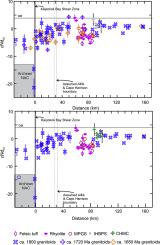Our official English website, www.x-mol.net, welcomes your
feedback! (Note: you will need to create a separate account there.)
Lithogeochemical and Nd isotopic constraints on felsic magmatism in the Makkovik Orogen, Labrador, Canada: Implications for assembly of the supercontinent Nuna
Lithos ( IF 2.9 ) Pub Date : 2021-02-01 , DOI: 10.1016/j.lithos.2020.105917 Alana M. Hinchey
Lithos ( IF 2.9 ) Pub Date : 2021-02-01 , DOI: 10.1016/j.lithos.2020.105917 Alana M. Hinchey

|
Abstract The formation of the supercontinent Nuna was a significant global crustal accretion event during the interval 1900 to 1800 Ma. Insight into its amalgamation is preserved in felsic volcanic of the Aillik Group and associated porphyritic intrusive rocks from the Makkovik Province. Lithogeochemical data indicate compositions typical of ferroan (A-type) felsic magmas. Trace-element ratios, such as high La/Yb(pm), are indicative of partial melting at high temperatures (~850–900 °C). Most samples have eNd(t) between +0.1 and −5.2, with T(DM) from 2773 to 2160 Ma, suggesting derivation through anatexis of predominantly Neoarchean to Paleoproterozoic sialic crust. One sample, however, has eNd(t =1860 Ma) = +3.0 and T(DM) of 1927 Ma, comparable with two other published values, indicative of a large component of juvenile asthenospheric material in its origin. This suggests that the felsic rocks may, alternatively, have been derived from a highly fractionated mantle melt with variable Neoarchean to Paleoproterozoic crustal contamination. It is likely that a mixture of both end-member models, anataxis and fractional crystallization, were active in the generation of these felsic magmas. The Aillik Group is genetically more closely related to the Cape Harrison arc than previously thought. It is, herein, proposed that there are likely only two domains (Kaipokok and Adlavik) preserved in the Makkovik Province. The Aillik Group was deposited in a backarc setting during the initial stage of the Cape Harrison arc, and was subsequently thrust over the Kaipokok arc. This thrusting resulted in the formation of crustal-scale shear zones that localized fluids and increased the metallogenic tenor of the region, consistent with the mode of formation of other accretionary belts of Nuna.
中文翻译:

加拿大拉布拉多 Makkovik 造山带长英质岩浆活动的岩石地球化学和 Nd 同位素约束:对努纳超大陆组装的影响
摘要 Nuna超大陆的形成是1900~1800 Ma期间全球一次重要的地壳增生事件。在艾利克群的长英质火山岩和来自 Makkovik 省的相关斑状侵入岩中保存了对其合并的洞察。岩石地球化学数据表明铁质(A 型)长英质岩浆的典型成分。痕量元素比率,例如高 La/Yb(pm),表明在高温 (~850–900 °C) 下部分熔化。大多数样品的 eNd(t) 介于 +0.1 和 -5.2 之间,T(DM) 介于 2773 至 2160 Ma,表明主要是通过新太古代到古元古代唾液地壳的显着地层的推导。然而,一个样本的 eNd(t =1860 Ma) = +3.0 和 T(DM) 为 1927 Ma,与其他两个公布的值相当,表明其起源中含有大量幼年软流圈物质。这表明,长英质岩石可能来自高度分异的地幔熔体,具有可变的新太古代到古元古代地壳污染。在这些长英质岩浆的生成过程中,很可能是端元模型(anataaxis 和分级结晶)的混合物。艾利克群在基因上与哈里森角弧的关系比以前认为的更密切。在此提出,马科维克省可能只保留了两个域(Kaipokok 和 Adlavik)。Aillik 群在哈里森角弧的初始阶段沉积在弧后环境中,随后被推到 Kaipokok 弧上。
更新日期:2021-02-01
中文翻译:

加拿大拉布拉多 Makkovik 造山带长英质岩浆活动的岩石地球化学和 Nd 同位素约束:对努纳超大陆组装的影响
摘要 Nuna超大陆的形成是1900~1800 Ma期间全球一次重要的地壳增生事件。在艾利克群的长英质火山岩和来自 Makkovik 省的相关斑状侵入岩中保存了对其合并的洞察。岩石地球化学数据表明铁质(A 型)长英质岩浆的典型成分。痕量元素比率,例如高 La/Yb(pm),表明在高温 (~850–900 °C) 下部分熔化。大多数样品的 eNd(t) 介于 +0.1 和 -5.2 之间,T(DM) 介于 2773 至 2160 Ma,表明主要是通过新太古代到古元古代唾液地壳的显着地层的推导。然而,一个样本的 eNd(t =1860 Ma) = +3.0 和 T(DM) 为 1927 Ma,与其他两个公布的值相当,表明其起源中含有大量幼年软流圈物质。这表明,长英质岩石可能来自高度分异的地幔熔体,具有可变的新太古代到古元古代地壳污染。在这些长英质岩浆的生成过程中,很可能是端元模型(anataaxis 和分级结晶)的混合物。艾利克群在基因上与哈里森角弧的关系比以前认为的更密切。在此提出,马科维克省可能只保留了两个域(Kaipokok 和 Adlavik)。Aillik 群在哈里森角弧的初始阶段沉积在弧后环境中,随后被推到 Kaipokok 弧上。











































 京公网安备 11010802027423号
京公网安备 11010802027423号